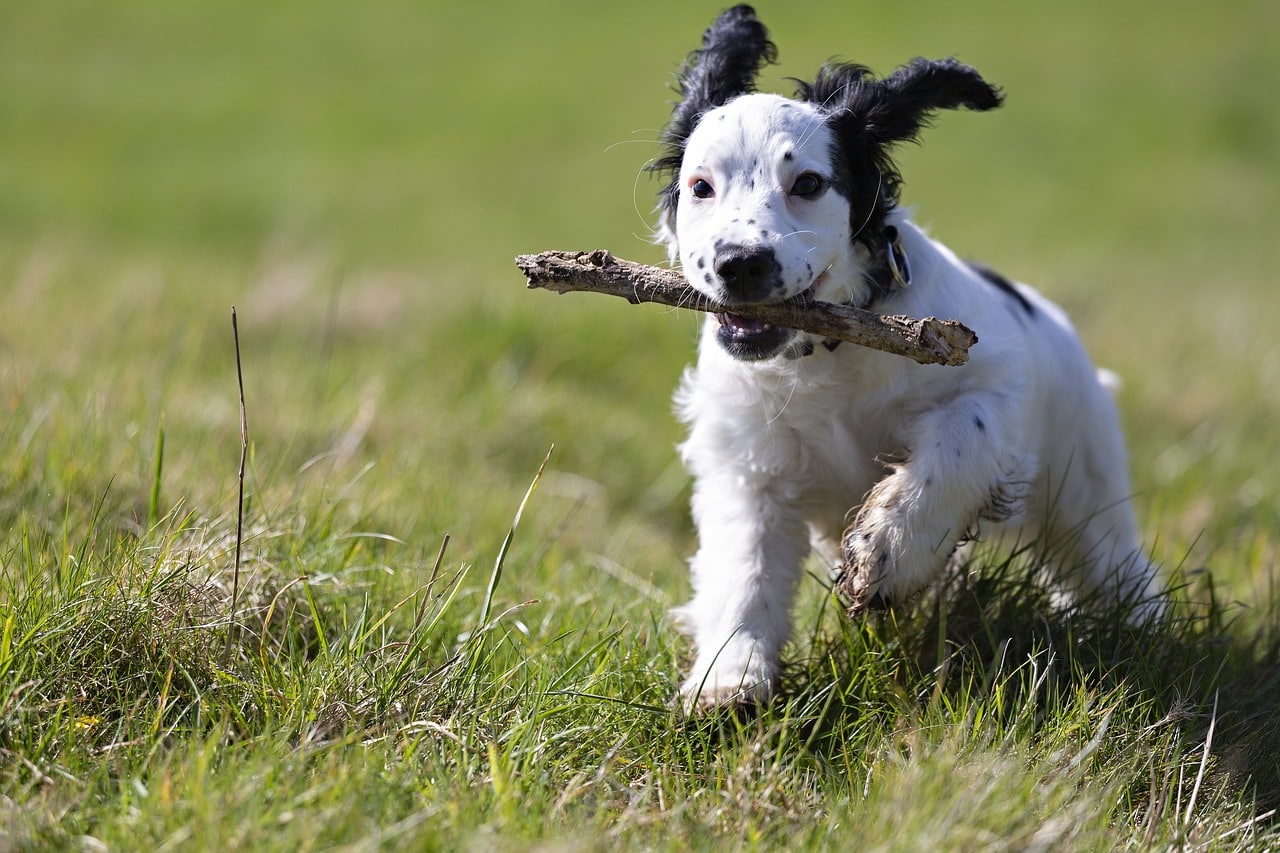Why do spaniels need to be able to perform blind retrieves?
One activity that your spaniel will have to perform well is retrieving.
At times and probably very often many of these retrieves will be unseen by your dog, and at times you, this is what we call ‘blind’ or a ‘blind retrieve’.
If, as the handler, we can see the area that the retrieve is in, such as a bird that is shot, where it has fallen, or ground game that we know is dead, where it lies, then we can handle and direct our spaniel to the area, thinking about wind direction, thus helping him to pick up the scent and gather the retrieve.
The purpose of teaching blind retrieves
There may be occasions, particularly if we are in a competition such as a trial or on a shoot, where there may be a bird down that needs picking and we don’t know where it is.
In a situation such as a competition, ie field trial, it may be the case that a dog has already been tried on the retrieve and has failed, so we are called over to attempt the retrieve also.
If we find it successfully then our competitor will be out and we will gain extra credit for the work.
In these circumstances we will be given some idea of the area in which the game lies, to give us at least some chance of success.
Or we could be on a shoot and have some role in performing picking up duties ( collecting game that has been shot). Normally this involves dogs conducting retrieves.
Shoots can be a free for all for some dogs, with many acting simply as ‘hoovers’ running around loose, collecting as much game as they can, sometimes snatching birds from other dogs, I’ve even seen dogs fight over retrieves on some shoots.
So, if you are working on a shoot, it is best to speak to one of the guns and ask if they have any birds down away from the general melee, and then work your spaniel in that area.
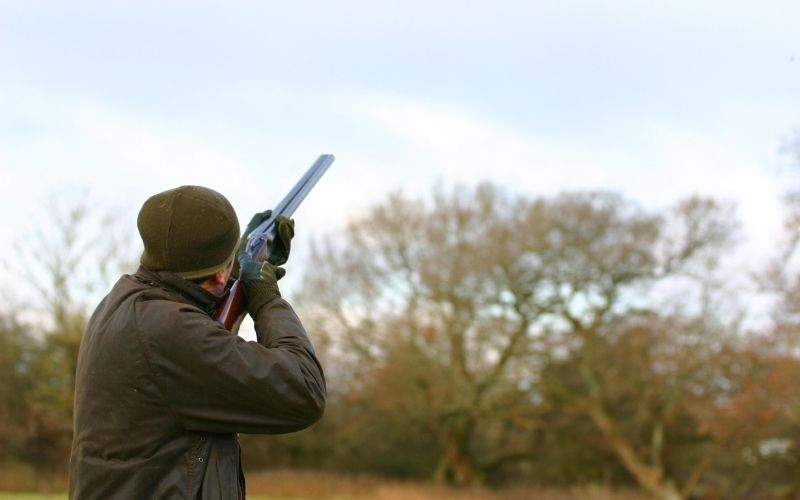
The whole point of gundog retrieving is to ensure that all game, or as much as is practically possible, is collected, and that any injured game is found and despatched quickly to prevent suffering.
I’ve been in both situations, in competition and shoot work, where birds have been shot and have fallen into areas where neither myself nor my dog have been or seen.
I’ve had to go in, with my spaniels, and recover the game.
This requires handling of the dog, awareness of the wind and scenting conditions, and, above all other things, an understanding of the spaniel and complete trust in his nose and ability.
Teaching blind retrieves to spaniels
Before we think about progressing onto blind retrieves our spaniel will already be retrieving to hand and will ideally be steady to the thrown dummy.
We should possess an array of training dummies, ideally the canvas type as these are softer and hold scent better than plastic or other solid training aids. Tennis balls are also good.
You should have a selection of training dummies







As a basic starter, walk the spaniel, on the lead or leash ( whichever you prefer to say), preferably in an area where there is some cover, such as rushes, light grass or light woodland.
Take one of your dummies and drop it into some cover, letting your spaniel see the dummy fall to the ground.
Keeping your spaniel on his lead, carry on walking, away from the dummy.
( note: it helps if you can ‘mark’ where the dummy is yourself, such as near a stick or particular tree trunk for example. This is simply to help you to find the dummy yourself, if your dog struggles – dummies are expensive and this is a lesson that I have learned).
When you are about twenty yards from the dummy, sit your spaniel down, take his lead off quietly, and send him for the retrieve using the ‘fetch’ command and pointing your right arm out in the direction of the dummy.
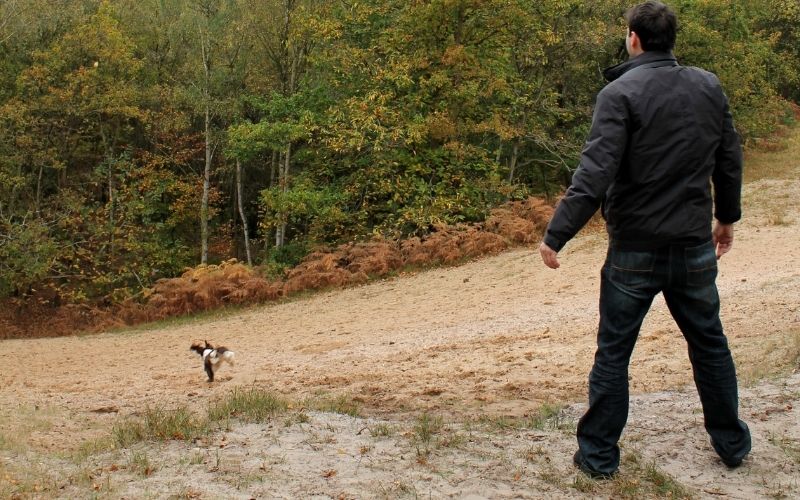
Your dog will run out and, chances are, he’ll miss the dummy and begin hunting for it when he reaches the general area.
If he picks it straight away then, great, good start, make the next one slightly more difficult.
Trusting your dog
Unless we have taught our spaniel to stop on the whistle and take hand signals we won’t be able to intervene in his quest for the dummy.
We need to let him look for it, trusting that he will use his nose to locate the dummy.
He may pull away from the area, casting himself into the wind to try and pick up the scent – this is a good sign, he’s thinking about it – he knows that the dummy is there, he saw you drop it and he knows that he is to retrieve it – you told him to – so he’s now trying to find it for you.
He may stop and look at you for confirmation – if he does then repeat the ‘fetch’ command and move forwards towards him, encouraging him to ‘fetch’.
It is important that he succeeds with this and we may even need to get close to the dummy to ensure that he retrieves it. Like all things with your spaniel that are new, slow and easy, always finish on a high with success.
When he gets the dummy and brings it to hand give him lots of praise and fuss.
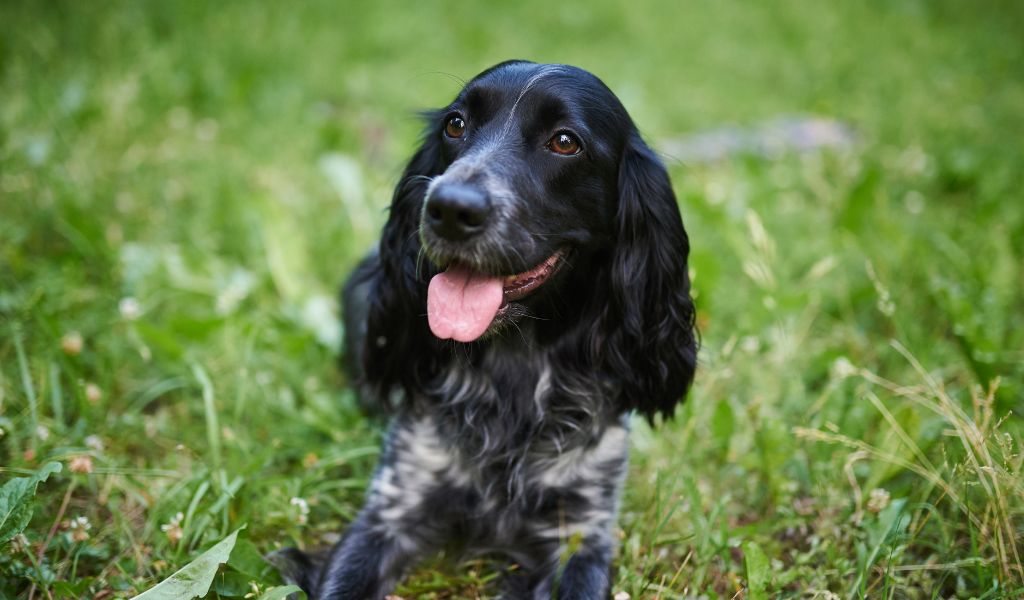
Get your dog to use his nose
We’re aiming to get the spaniel using his nose and learning how to use the wind direction to pick up scent.
We cannot tell him about scent or how to smell things, we can only create conditions and scenarios to help him to learn how to use his superior scenting senses in a way that develops him into a good working spaniel and gundog.
As we progress with our exercises we can use different types of dummies, such as fur or feather,which will have different smells for your spaniel to become familiar with.
We can also use tennis balls.
If you spit on a tennis ball and then roll it along the ground, you will create a scent trail for your spaniel to pick up, if the ball goes into cover then you are also creating a ‘blind’ type of retrieve. Another lesson for your dog.
Like all things we are seeking to expand his mind, increasing his knowledge, experience and his overall skill.
If we think creatively and make use of simple opportunities when we are out ‘spanielling’ with our dogs then we can quickly and easily make progress.
Handling and directions on blind retrieves
There is a place for handling while performing blind retrieves with your gundog, but this only really applies if you, as the handler, have an idea of where the retrieve lies.
You may have seen the bird or dummy fall into a certain area, or you may have been told by someone else roughly where the retrieve sits.
If we trust our spaniel and he knows how to use his nose and work the scent, then all we really need to do is get him to the area where the retrieve lies.
We should be able to let him get on with his job.
Before we consider intervening and stopping and directing the dog on retrieves of this type, we need to consider whether we have been given correct information about the retrieve.
Is it actually there? Has the person that told us given us accurate information? Have I seen properly, am I sure that it is there? Is the retrieve dead? Could it have been injured and run off?
I’ve been caught out more than once with this.
I recall being in a spaniel stake in North Yorkshire many years ago.
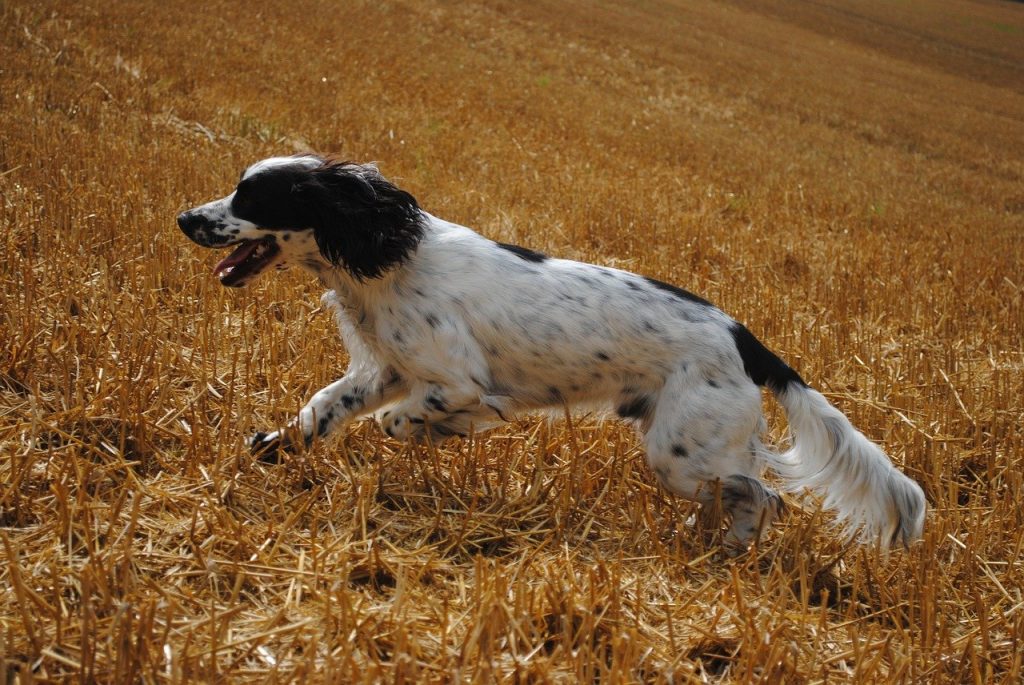
My English Springer bitch Twig was a great working spaniel.
We were working a patch of dead bracken and she’d flushed a couple of pheasants that had been shot, she made good work of both retrieves which were blind as they had fallen over the crest of a mound out of view.
The dog to our left had a bird down which had been shot be their gun, the bird fell over a dry stone wall, into a patch of rushes.
The dog went out quickly, over the wall and hunted for the bird for a good five minutes until it was called in, having failed to locate the bird.
Twig and I were called over to try.
At this point I was informed that the bird was a ‘runner’ – it had been shot but was not dead and had ‘run off’ – hence runner.
The gun told me that he had seen the bird fall into some rushes so I sent Twig into them, she made short work of the rushes and began to pull away along a faint game trail with her nose down.
The gun was insistent that the bird was in the rushes, so I stopped her and sent her back in.
She looked at me as though saying ‘It’s not there’ but I maintained and sent her back in.
Again she bashed them around and set off along the game trail with her nose down.
We failed on that retrieve because I listened to the gun ( who failed to kill the bird with his shot) and didn’t listen or trust the dog.
I learned from this lesson and Twig and I went onto get several field trial awards in later competitions.
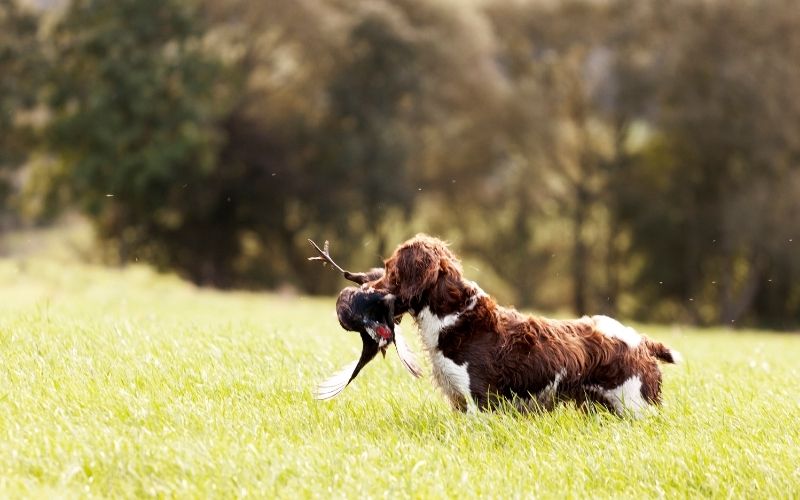
Learn from your dog
Learn to trust your dog. Give him lots of opportunities in training to hunt out and find retrieves.
Place dummies in different types of cover, gradually making them more difficult to find.
Make use of different weather conditions, from drizzle to pouring with rain, sun to snow, sleet and hail.
Wind and breeze to borderline hurricane.
Goto different places and use different types of cover. Try rushes, deep grass, light grass, woodland, bracken, brambles, heather.
Get your spaniel familiar with different cover types and weather conditions.
Get him using his nose and give him every opportunity to use his nose in as many different environments as you can.
I mention using a fur dummy for spaniel training and this is a photo of the one that I use. I bought this from Amazon a few years ago and it’s worn well.
You could also make one from a standard canvas dummy and stich fur or fur replacement onto it.
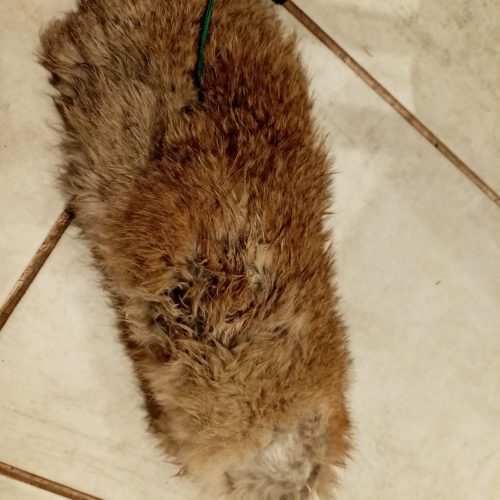
Boris my Cocker spaniel demonstrates a blind retrieve
Out in the woods near to home with Boris and Nimrod. A wet day with the wind blowing from behind my right.
I’ve placed the fur skinned dummy near to the roots of a fallen tree, about thirty yards away. Boris doesn’t know that it is there.
I’ve used the fur dummy as it has more scent and this was a really wet day, I wanted Boris to get this right first time.
I’ll send Boris out for the retrieve, using the command that I use’ fetch’.
Now, as the wind is coming from behind me, chances are that Boris will need to get beyond the dummy in order to ‘wind’ it (pick up it’s scent). The wind has a slight ‘right hand’ aspect to it, so he’ll probably pull over to the left as well.
The video shows Boris in action, using the wind and picking the retrieve.
You’ll see that I stop Boris mid retrieve and handle him using the command ‘back’ to get him into the wind so that he smells and picks the dummy up.
I’ll cover the stop whistle and directional commands in future posts. I just want to show you the importance of the wind and your dog’s nose in the blind retrieve process.
Hopefully the video will help and will give you some ideas for getting your spaniel working and developing his senses.
Final words
Start off with simple, easy to locate retrieves that your spaniel will find without too much difficulty.
This will help to build his confidence in himself and his belief in you – that there really is something out there to bring back.
Use a variety of dummies and look for opportunities to set up a blind training exercise when you are out training.
Don’t overdo things but gradually make the retrieves more difficult and challenging for your spaniel so that his knowledge and ability steadily increases.

